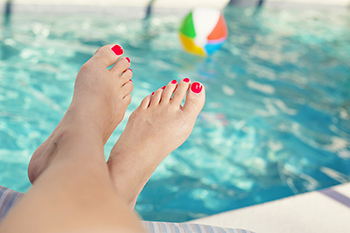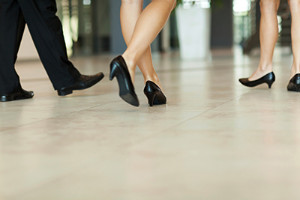Connect With Us
Blog
Items filtered by date: October 2022
Can Blisters Be Prevented?

A blister can cause annoyance and discomfort to people who enjoy running. Blisters are defined as a small area of skin that resembles a bubble. It is filled with a fluid that protects the damaged skin as new skin forms underneath it. It is considered to be the body’s natural defense mechanism as the skin heals. A blister generally develops as a result of friction that can come from wearing shoes and socks that do not fit correctly. Blisters can be painful and may become infected, if not treated properly. There are some patients who notice blisters have formed from having an allergic reaction, or from medical conditions like eczema and psoriasis. There are specific things that can be done to protect the blister. These include refraining from bursting or peeling the blister away from the skin and wearing shoes that do not rub against the blister. If you have a blister that won’t heal or becomes infected, please consult with a podiatrist who can offer you methods on how to avoid getting blisters on the feet.
Blisters are prone to making everyday activities extremely uncomfortable. If your feet are hurting, contact David A. Edmonds, DPM of Advanced Podiatry Associates. Our doctor can provide the care you need to keep you pain-free and on your feet.
Foot Blisters
Foot blisters develop as a result of constantly wearing tight or ill-fitting footwear. This happens due to the constant rubbing from the shoe, which can often lead to pain.
What Are Foot Blisters?
A foot blister is a small fluid-filled pocket that forms on the upper-most layer of the skin. Blisters are filled with clear fluid and can lead to blood drainage or pus if the area becomes infected.
How Do Blisters Form?
Blisters on the feet are often the result of constant friction of skin and material, usually by shoe rubbing. Walking in sandals, boots, or shoes that don’t fit properly for long periods of time can result in a blister. Having consistent foot moisture and humidity can easily lead to blister formation.
Prevention & Treatment
It is important to properly care for the affected area in order to prevent infection and ease the pain. Do not lance the blister and use a Band-Aid to provide pain relief. Also, be sure to keep your feet dry and wear proper fitting shoes. If you see blood or pus in a blister, seek assistance from a podiatrist.
If you have any questions, please feel free to contact our offices located in Northampton and Allentown, PA . We offer the newest diagnostic and treatment technologies for all your foot care needs.
Why You Should Wear Shoes for Water Aerobics

Water aerobics is a popular choice of exercise for many people. While shoes are not required, there is a good reason to wear shoes for this activity. Water shoes can help prevent foot pain and increase traction on the pool floor. Water aerobics involves jumping up and down on hard pool floors. Walking or bouncing on the bottom of the pool can eventually cause foot pain, a primary reason for wearing water shoes. However, these shoes can also prevent foot blisters. Since the skin on the feet softens and prunes in the water, it becomes more sensitive than if the feet were dry. Wearing a non-slip water shoe during water aerobics is important for injury prevention. Slipping can cause blisters as well as friction burns. Water shoes will provide stability in the water as the lack of body control is heightened due to added resistance. Slip-resistant shoes will provide more control and better performance of exercises. If you participate in water aerobics and sustain foot injuries or want to learn more about how to prevent foot injuries while engaging in this activity, contact a podiatrist to discuss.
Ankle and foot injuries are common among athletes and in many sports. They can be caused by several problems and may be potentially serious. If you are feeling pain or think you were injured in a sporting event or when exercising, consult with David A. Edmonds, DPM from Advanced Podiatry Associates. Our doctor will assess your condition and provide you with quality foot and ankle treatment.
Common Injuries
The most common injuries that occur in sporting activities include:
- Achilles Tendonitis
- Achilles Tendon Rupture
- Ankle Sprains
- Broken Foot
- Plantar Fasciitis
- Stress Fractures
- Turf Toe
Symptoms
Symptoms vary depending upon the injury and in some cases, there may be no symptoms at all. However, in most cases, some form of symptom is experienced. Pain, aching, burning, bruising, tenderness, tightness or stiffness, sensation loss, difficulty moving, and swelling are the most common symptoms.
Treatment
Just as symptoms vary depending upon the injury, so do treatment options. A common treatment method is known as the RICE method. This method involves rest, applying ice, compression and elevating the afflicted foot or ankle. If the injury appears to be more serious, surgery might be required, such as arthroscopic or reconstructive surgery. Lastly, rehabilitation or therapy might be needed to gain full functionality in the afflicted area. Any discomfort experienced by an athlete must be evaluated by a licensed, reputable medical professional.
If you have any questions, please feel free to contact our offices located in Northampton and Allentown, PA . We offer the newest diagnostic and treatment technologies for all your foot care needs.
It's Time for Beautiful Feet
Simple Methods to Protect Your Feet During the Workday

The feet carry the weight of the body, and can endure an excessive amount of stress during the work day. Many people have professions that require standing or walking for the majority of the day, and that can wreak havoc on the body. This can increase the risk of having foot pain and discomfort, and it can be difficult to complete daily activities. It is beneficial to wear shoes that fit correctly, and this may help to alleviate the pain. Some patients add a cushioned insole to their shoe, in addition to wearing shoes that have laces which can provide maximum support to the feet and the body as the workday progresses. At the end of the day, the feet will feel better when they are washed, and this may be helpful in preventing fungus from developing. Consuming a healthy diet may help to avoid or limit dehydration, which may result in having foot pain. If you have a career that requires standing, please confer with a podiatrist who can discuss methods of how to prevent potential foot pain.
While working on the feet, it is important to take the proper care of them. For more information about working on your feet, contact David A. Edmonds, DPM from Advanced Podiatry Associates. Our doctor will treat your foot and ankle needs.
Working on Your Feet
Standing on your feet for long periods of time can cause stress and pain in your feet. Your whole body may experience change in terms of posture, back pain, bunions, callouses and or plantar warts. There are ways to avoid these conditions with proper foot care, smart choices and correct posture.
Positive Changes
Negative heeled shoe – Choosing this shoe type places the heel slightly lower than the ball of the foot. These are great for overall foot health. Find shoes that fit you correctly.
Go barefoot – Our feet were not designed to be enclosed for all hours of the day. Try to periodically expose your feet to air.
Eliminate Pain
Foot Exercises – Performing simple exercises, incorporating yoga and doing stretches are beneficial. This will allow increased blood flow to the area and muscles of the foot.
Achilles tendon – Stretching the foot out flat on the floor will relax the calf muscles and tendon. These exercises can be performed almost anywhere. Make sure you add these exercises to your daily regimen.
With a little bit of this information and knowing more about foot health, you will notice changes. Foot stretches and proper footwear will help with pain and prevent further issues.
If you have any questions please feel free to contact our offices located in Northampton and Allentown, PA . We offer the newest diagnostic and treatment technologies for all your foot and ankle needs.
A Broken Foot and a Sprained Ankle May Share the Same Symptoms

A broken foot often requires immediate medical attention. It generally causes severe pain and discomfort and can happen for a variety of reasons. These include a foot injury, twisting it well beyond its normal range of motion, or an accident. Symptoms include swelling, bruising, and difficulty bearing weight. If the foot is severely fractured, a bone may protrude from the skin, appearing to be displaced. A mildly broken foot may be confused with a sprain, because the two types of injuries share similar symptoms. Some patients hear a popping sound, which is often indicative of a broken foot, rather than a sprained ankle. A proper diagnosis can confirm a broken foot by having an X-ray taken. Treatment can begin by having a cast put on the affected foot, which is helpful in providing stability as the healing process occurs. Crutches are often recommended to use while the foot is in a cast, helping the patient to remain mobile. If you have broken your foot, please call a podiatrist’s office as quickly as possible for proper treatment techniques.
A broken foot requires immediate medical attention and treatment. If you need your feet checked, contact David A. Edmonds, DPM from Advanced Podiatry Associates. Our doctor can provide the care you need to keep you pain-free and on your feet.
Broken Foot Causes, Symptoms, and Treatment
A broken foot is caused by one of the bones in the foot typically breaking when bended, crushed, or stretched beyond its natural capabilities. Usually the location of the fracture indicates how the break occurred, whether it was through an object, fall, or any other type of injury.
Common Symptoms of Broken Feet:
- Bruising
- Pain
- Redness
- Swelling
- Blue in color
- Numbness
- Cold
- Misshapen
- Cuts
- Deformities
Those that suspect they have a broken foot shoot seek urgent medical attention where a medical professional could diagnose the severity.
Treatment for broken bones varies depending on the cause, severity and location. Some will require the use of splints, casts or crutches while others could even involve surgery to repair the broken bones. Personal care includes the use of ice and keeping the foot stabilized and elevated.
If you have any questions please feel free to contact our offices located in Northampton and Allentown, PA . We offer the newest diagnostic and treatment technologies for all your foot and ankle needs.

